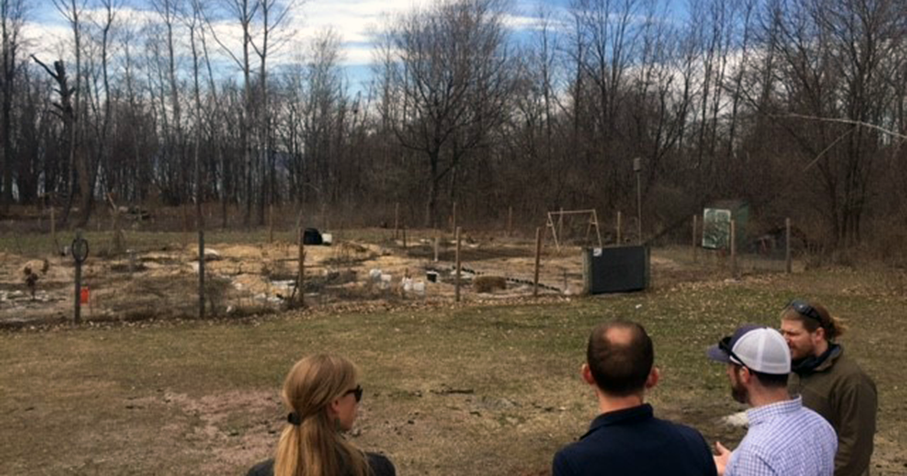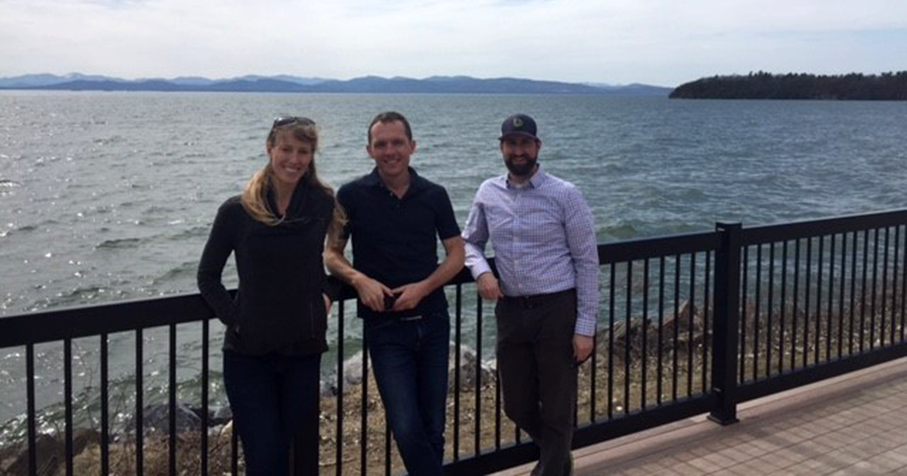Three Days in Vermont
Jun 13 2017
Greetings RSF Community!
Earlier this spring, Kate and I spent an eventful few days in Vermont, and I wanted to recap some of the highlights of our short, but geographically-intensive trip.
Starting in Burlington, we zipped up and down the state by car, stopping to visit some of our borrowers, partners, and a slew of other game-changing social enterprises in the state — doing everything from revolutionizing local food systems to promoting solar energy solutions — in order to see how they function and carry out their mission.
Without further ado, allow me to show you a selection of the trailblazing members of our community in the Green Mountain State.
Day 1: Burlington, VT | Waitsfield, VT
First, we linked up with Nick Richardson and other representatives from RSF borrower Vermont Land Trust (VLT), a non-profit environmental organization working to preserve the recreational and scenic lands that give the state its rural character.
The next three photos were taken on a piece of land that connects the New North End, one of Burlington’s most diverse neighborhoods, with the stunning Lake Champlain. VLT stewards this land along with the help of the Burlington Parks, Recreation & Waterfront department. They plan to plant and maintain trees and shrubbery on this plot that would otherwise be cleared for residential housing. Keeping this area wooded is important for the quality of the lake water, which can become contaminated if housing development inches too close.

Above is a photo of one of the works-in-progress. It’s a blazed trail that will connect the New North End all the way to the shore of the lake, allowing Burlington’s community to access lakeside recreational areas by walking or biking.

After walking up the hill, the leaves and twigs crunching under our feet, we stopped to check out a community garden on the property. While it’s normally overflowing fresh fruits and vegetables, the plants in the garden are dormant, but will start to bloom again when the weather gets warmer in a couple of months.

The trail ends at the shore of the stunning Lake Champlain. Kate and the staff from VLT are standing on a walking/biking path for pedestrians. This will allow residents speedy access to the beaches and recreational areas along the shoreline; however, nobody was swimming in this chilly Vermont April.
Seeing this project in person was an incredible feeling because we realized how it benefitted hundreds of Burlington residents by bringing outdoor recreational access within walking distance for families and children.

The Intervale Center’s Community Barn – Photo by Abby Portman
Later in the afternoon, we visited the Intervale Center, an RSF borrower that stewards over 350 acres of land along the Winooski River, which flows into Lake Champlain. The organization converted this land, known as the Intervale, into a community centered on growing and celebrating local food. Housed at this location are innovations the Center has provided Burlington’s residents, such as local food incubators and large-scale composting.

Trucks used for distribution
To cap off the day, we caught up with Robin Morris of the Mad River Food Hub, a meat processing facility in the Mad River Valley. We wanted to see its efforts to bring the sustainability and local food movements to this historically agricultural region. The hub serves the community by providing local foods, as well as helping to grow small-scale food producers by allowing them to rent the production facility at affordable rates.
Day 2: Norwich | Battleboro | Charlotte
This was the day we yo-yoed up and down the state of Vermont. We started off in Norwich to visit Clean Yield Asset Management, Veris Wealth Partners, and the New Hampshire Charitable Foundation—three fund-managing organizations that provide loans to sustainable businesses.
One of the big topics of discussion was Vermont’s agricultural industry, and because the state is the largest food producer in New England, we listened to understand current initiatives encouraging a new generation of Vermont farmers to take to the soil.

Paddock on Retreat Farm with two run-in sheds housing donkeys.
Afterwards, we drove to the town of Battleboro in the southeastern corner of the state to visit Buzz Schmidt, Executive Director at Retreat Farm. The complex was once operated by an adjacent psychiatric hospital and while it’s already big and beautiful, they’re renovating parts of their complex to include a courtyard and additional buildings. Schmidt hopes the space will serve as a community center for Battleboro, as well as a retreat destination and community farm for agricultural groups and students.
Finally, we shot up to two farms in Charlotte, Vermont: Miskell’s Farm and Adam’s Berry Farm.
Miskell’s Farm produces tomatoes and other crops in an extensive network of growing facilities, Kate was blown away at how the greenhouses were organized to optimize their production of organic tomatoes.

Adam’s Berry Farm, berries coming soon.
Adam’s Berry Farm, whose 80 acres of fields yield strawberries, blueberries and raspberries in the summer months, make the farm a popular destination for berry picking. The farm also boasts a fruit popsicles pop-up stand once the weather gets warm, demonstrating multiple ways local people can come together to celebrate the food grown in their communities.
Day 3: Ghent, NY | Waterbury, VT | Burlington, VT
On day number three, Kate took off to go to Ghent, New York, just on the Vermont border to visit our borrower, Hawthorne Valley Farms, which is advancing biodynamic agriculture in the Hudson Valley and New York City.
Meanwhile, I stayed in Vermont to meet with two organizations in the ecological stewardship space, SunCommon and Commons Energy, both of which concentrate on providing alternative energy solutions to Vermonters, with options ranging from residential solar home systems, to commercial energy efficiency solutions. The promising growth of these two enterprises shows us that there’s a bright future for solar energy in the Green Mountain State… no pun intended.
Thank you for joining Kate and me on this virtual journey up and down the state of Vermont. It was a joy to reconnect with our borrowers and partners and see for ourselves the amazing work they’re doing in both the food & agriculture and ecological stewardship spaces.
Until next time!
Stu
Stu is a senior associate on RSF’s social enterprise lending team.